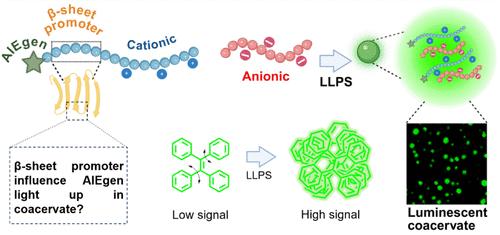β-Sheet Structures Enhance Aggregation-Induced Emission Signals in Peptide-Based Coacervates
IF 7
2区 材料科学
Q2 CHEMISTRY, PHYSICAL
引用次数: 0
Abstract
Phase-separating peptides (PSPs) are known to undergo liquid–liquid phase separation (LLPS) to produce coacervates with applications in bioimaging, drug delivery, and theranostics. However, the structure–function relationship of the peptide building blocks remains unclear. Here, we used an aggregation-induced emission reporter to study how different β-sheet promoters impact coacervation. We synthesized an anionic Asp-peptide (D10) and a cationic Arg-peptide (R10) covalently conjugated to tetraphenylethene pyridinium (PyTPE)─an aggregation-induced emission generator (AIEgen). We included several spacer units composed of β-sheet-promoting self-assembling peptides (F2G2, W2G2, FFVLK, and GFFYK) between the AIEgen and R10 and investigated their size and AIE intensities after coacervation. The properties of the coacervates vary with endogenous factors (peptide sequence, number of Arg and Asp residues, charge ratio, and total charge equivalent concentration of peptides), exogenous factors (pH, ionic strength, salts), and the β-sheet content of the constituting peptide. We observed that a minimum 10 mM phosphate buffer salt concentration, pH 4–12, total charge equivalent concentration of 0.8 mM, and charge ratio (R10/D10) of 0.5 are required for 100% peptide complexation. Peptides containing the FFVLK sequence exhibited the highest AIE (∼450-fold) with the capability to form self-coacervates in phosphate buffer. The W2G2 motif had negligible activation. Finally, we confirmed that the coacervates retain their shape after intracellularly labeling murine colon adenocarcinoma cells (MC38) via caveolae-mediated endocytosis with >95% cell viability.

β-薄片结构增强肽基凝聚体中聚集诱导的发射信号
相分离肽(PSPs)已知经过液-液相分离(LLPS)产生凝聚体,应用于生物成像,药物输送和治疗学。然而,肽构建块的结构-功能关系尚不清楚。在这里,我们使用聚集诱导发射报告来研究不同的β-片启动子如何影响凝聚。我们合成了一个阴离子的Asp-peptide (D10)和一个阳离子的Arg-peptide (R10)共价偶联到四苯基乙烯吡啶(PyTPE)──一个聚集诱导发射发生器(AIEgen)。我们在AIEgen和R10之间加入了几个由促进β-薄片自组装肽(F2G2、W2G2、FFVLK和GFFYK)组成的间隔单元,并研究了它们的大小和凝聚后的AIE强度。凝聚体的性质受内源因素(肽序列、Arg和Asp残基数目、电荷比和肽总电荷等效浓度)、外源因素(pH、离子强度、盐类)和构成肽的β-片含量的影响。我们观察到,磷酸缓冲盐的最低浓度为10 mM, pH为4-12,总电荷当量浓度为0.8 mM,电荷比(R10/D10)为0.5,可以达到100%的肽络合。含有FFVLK序列的肽显示出最高的AIE(约450倍),并具有在磷酸盐缓冲液中形成自凝聚的能力。W2G2基序的激活可以忽略不计。最后,我们证实,在细胞内标记小鼠结肠腺癌细胞(MC38)后,通过小泡介导的内吞作用,凝聚体保持其形状,细胞存活率为95%。
本文章由计算机程序翻译,如有差异,请以英文原文为准。
求助全文
约1分钟内获得全文
求助全文
来源期刊

Chemistry of Materials
工程技术-材料科学:综合
CiteScore
14.10
自引率
5.80%
发文量
929
审稿时长
1.5 months
期刊介绍:
The journal Chemistry of Materials focuses on publishing original research at the intersection of materials science and chemistry. The studies published in the journal involve chemistry as a prominent component and explore topics such as the design, synthesis, characterization, processing, understanding, and application of functional or potentially functional materials. The journal covers various areas of interest, including inorganic and organic solid-state chemistry, nanomaterials, biomaterials, thin films and polymers, and composite/hybrid materials. The journal particularly seeks papers that highlight the creation or development of innovative materials with novel optical, electrical, magnetic, catalytic, or mechanical properties. It is essential that manuscripts on these topics have a primary focus on the chemistry of materials and represent a significant advancement compared to prior research. Before external reviews are sought, submitted manuscripts undergo a review process by a minimum of two editors to ensure their appropriateness for the journal and the presence of sufficient evidence of a significant advance that will be of broad interest to the materials chemistry community.
 求助内容:
求助内容: 应助结果提醒方式:
应助结果提醒方式:


